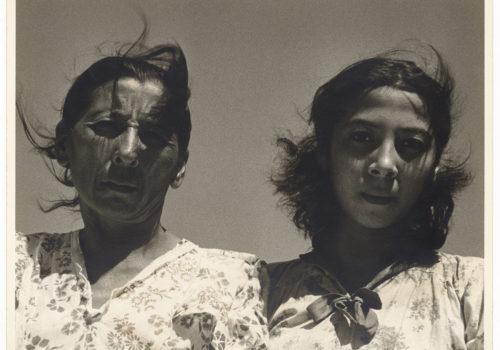Alfredo Boulton (1908–1995) is considered one of the most important champions of modern art in Venezuela and a key intellectual of twentieth-century modernism. He was a pioneer of modern photography, an art critic, a researcher and historian of Venezuelan art, a friend to many of the great artists and architects of the twentieth century. Despite the important role Boulton played, he is shockingly underrecognized outside of his home country. To remedy that, Getty Research Institute has organized Alfredo Boulton: Looking at Venezuela, 1928– 1978, an exhibition that celebrates Boulton’s many dimensions and accomplishments.
Drawn extensively from the trove of papers and photographs in the Alfredo Boulton archive, which the Getty Research Institute acquired in 2020, the exhibition explores Boulton from several angles, focusing on this photographic work, his connections to the artists of his time, and his crucial involvement in the development of art history in Venezuela.
“The exhibition, Alfredo Boulton: Looking at Venezuela, brings to light a brilliant eye behind the lens in Latin-American photography, and a name largely unknown in the US, and through this body of work we also demonstrate Getty’s commitment to collecting artist archives, and to making them available to the public,” says Mary Miller, director of the Getty Research Institute.
Boulton was born into a wealthy family in Caracas and was educated in Switzerland and the United Kingdom. His time in Europe included frequent visits to Paris, where he became acquainted with artists of the avant-garde. In 1928, Boulton returned to Venezuela, where a new generation was pushing to modernize and transform the country. Over the next four decades Venezuela would become one of the main centers of modernity in Latin America, forming a vibrant artistic scene in which Boulton actively participated.
The exhibition will be divided into three thematic sections analyzing different aspects of his persona. The first part, Boulton the Photographer, focuses on Boulton’s photographic discourse, highlighting his combination of vernacular themes with the use of a highly sophisticated modern vocabulary. Boulton’s first photographs were inspired by European and American photographers, particularly Man Ray (American, 1890-1976) and Surrealism. In this period, he produced close shots, generally of objects, with many musical and literary references. However, Boulton was interested in generating art that represented Venezuela’s distinctive identity. By the mid-1930s he had begun making portraits of local people. Through these images Boulton fashioned an idealized Venezuelan archetype based on the concept of belleza criolla, the term he coined to describe the beauty resulting from the mix of the three races present in Venezuela’s population—white, Indigenous, and Black. At the same time Boulton proved instrumental in creating an integrated visual image of his country; he photographed many Venezuelan landscapes and regions that had never been documented, feeling compelled to capture what was rapidly modernizing and changing.
Boulton and Modern Art, centers on Boulton’s relationship with Venezuelan artists of his time. He befriended, advised, and promoted artists, while also acquiring their works for his private collection. This section also features Boulton’s house in Pampatar, Margarita Island. The house was a great example of Boulton’s vision of Venezuela’s ideal modernity. Purchased in 1952, it was a colonial construction that he remodeled and decorated with art and furniture by Alexander Calder, Alejandro Otero, and other major artists of his time, creating a fusion of modern art and the country’s history and traditions. The Pampatar house connected him to the groundbreaking generation of artists, architects, and designers in his country including Jesús Soto, Carlos Raúl Villanueva, Miguel Arroyo, and Francisco Narváez. The exhibition will include several loans of works of art that were part of Boulton’s collection.
The last section, Boulton the Art Historian, examines Boulton’s work as a researcher. By around 1956, Boulton had abandoned his photography practice to focus on his work as a researcher, art historian, and curator. He then dedicated 40 years of his life to building a comprehensive analysis of the history of art in his country, from the colonial period onward. At the time, there was no prior literature for him to cite or organized archives and catalogs to research. Still, Boulton published more than 60 books, including his groundbreaking three-volume Historia de la pintura en Venezuela (History of Painting in Venezuela), published from 1964 to 1972.
“Alfredo Boulton was a pivotal figure in 20th-century art,” says Idurre Alonso, curator at the Getty Research Institute. “He played a crucial role in shaping the cultural landscape of Venezuela and was a leading figure in the development and appreciation of modern art in the country. His contributions have not only enriched the understanding of Venezuelan art but have also helped to the broader appreciation of Latin American art. This exhibition, and the accompanying catalogue, aim to shed light on his multifaceted impact and significance within the context of modernity.”
The exhibition is curated by Idurre Alonso, curator at the Getty Research Institute.
Alfredo Boulton: Looking at Venezuela (1928-1978)
August 29, 2023, through January 21, 2024
Getty Research Institute
1200 Getty Center Dr #1100
Los Angeles, CA 90049
https://www.getty.edu/research/institute/
















